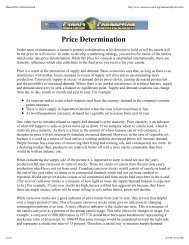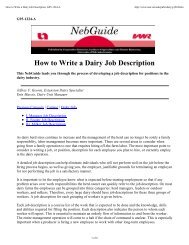Malt Preferences of the Craft Brewing Industry - Agricultural ...
Malt Preferences of the Craft Brewing Industry - Agricultural ...
Malt Preferences of the Craft Brewing Industry - Agricultural ...
Create successful ePaper yourself
Turn your PDF publications into a flip-book with our unique Google optimized e-Paper software.
Currently craft brewers are not completely satisfied with <strong>the</strong> malt <strong>the</strong>y receive.As a result, potential niche marketing opportunities exist. Brewers responding to <strong>the</strong>survey expressed <strong>the</strong> importance certain malt characteristics hold in <strong>the</strong>ir purchasingdecision. Some <strong>of</strong> <strong>the</strong> needs and desires for malt, both base and specialty, are not met by<strong>the</strong> current maltster. Catering to <strong>the</strong> needs and desires <strong>of</strong> craft brewers provide potentialniche marketing opportunities.<strong>Malt</strong> needs and preferences in <strong>the</strong> craft brewing industry should be addressed by<strong>the</strong> malting industry. Catering to <strong>the</strong> needs and preferences <strong>of</strong> microbreweries orbrewpubs presents potential marketing opportunities for malt suppliers. <strong>Malt</strong> barleyproducers in Wyoming and <strong>the</strong> Rocky Mountain region could benefit from an overallincreased demand for malt, especially if <strong>the</strong> malt demand is locally or regionallyproduced. Respondents to <strong>the</strong> survey overwhelmingly preferred high quality 2-rowwhole kernel malt. This suggests increased market potential exists for <strong>the</strong> 2-row maltbarley grown here as compared to <strong>the</strong> 6-row varieties grown in <strong>the</strong> midwest.Unfortunately, a large portion <strong>of</strong> <strong>the</strong> malt supplied to <strong>the</strong> craft brewing industry comesfrom maltsters using 6-row varieties.Potential may exist for a small group <strong>of</strong> producers to benefit from <strong>the</strong>se possiblemarketing opportunities by becoming <strong>the</strong> marketer, effectively cutting out <strong>the</strong> “middleman”and retaining a portion <strong>of</strong> <strong>the</strong> pr<strong>of</strong>its earned for <strong>the</strong>mselves. However, it must beremembered that this is a very small volume or niche market and it is likely only a smallconcentration <strong>of</strong> producers could capitalize on this potential.Many issues must be addressed before a group <strong>of</strong> producers could considerproducing and marketing <strong>the</strong>ir own malt. Ano<strong>the</strong>r portion <strong>of</strong> this project studies <strong>the</strong>37
















